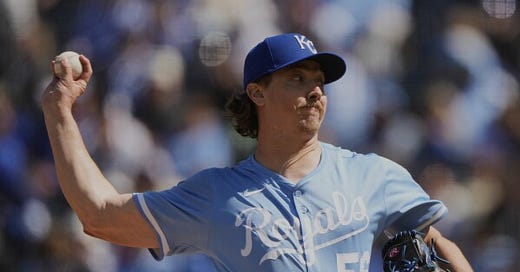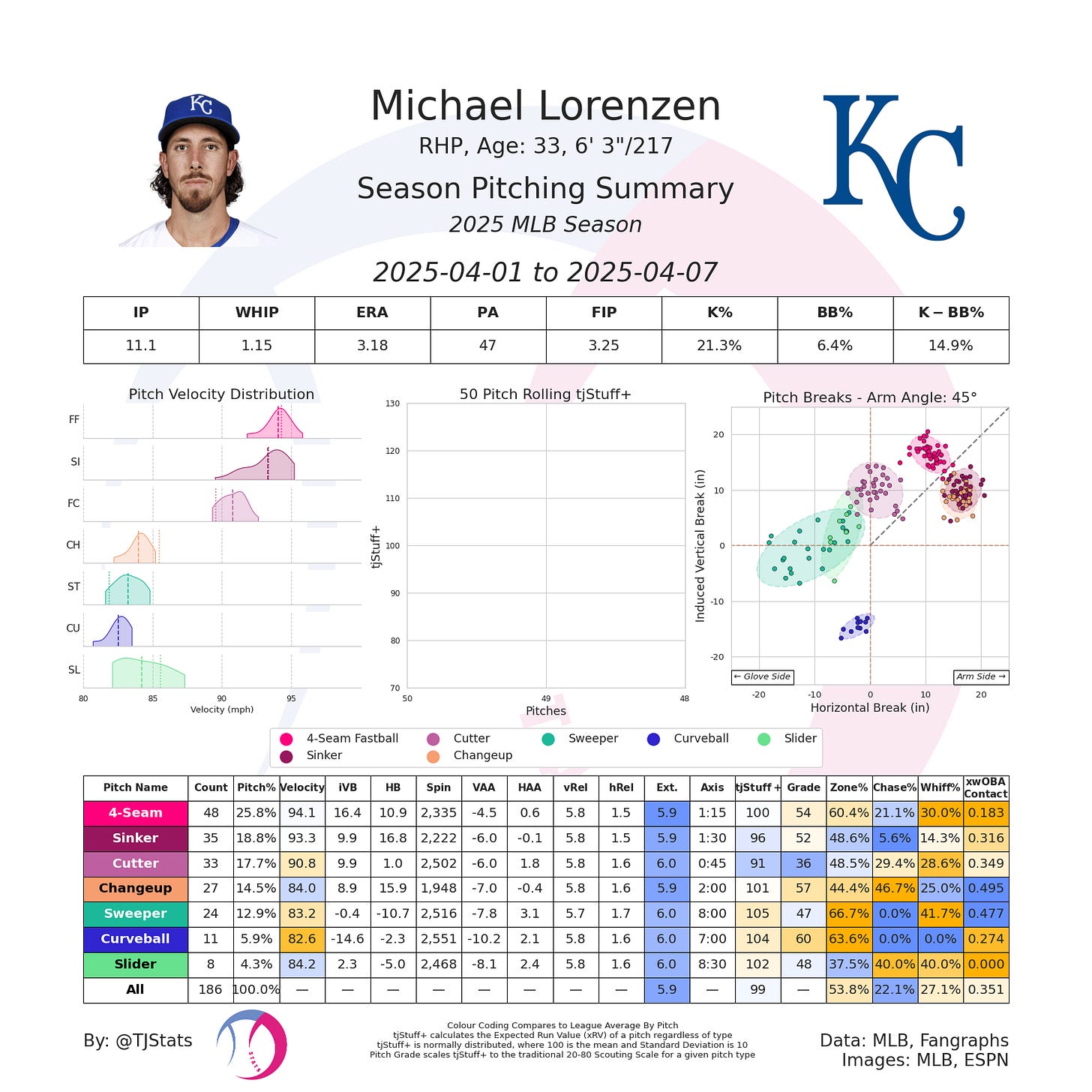The Unsung Third Star of the Royals Bullpen
Hunter Harvey blanks opponents without the light shows or GIFs
Kansas City’s last two wins, including the 4-2 series-opening victory over Minnesota on Monday night, followed a familiar end-of-game pattern.
The seventh inning ends. The Kauffman Stadium lights go out. Lucas Erceg, to great fanfare and lack of illumination, makes his pilgrimage from the right field bullpen to the center of the diamond to defend the eighth inning.
Once the eighth inning winds down, offseason acquisition and closer-turned-cartoon Carlos Estevez takes his turn, nailing down the game and departing to a flurry of cheers, GIFs and #HEYHEYHEYHEYs.
But before those two burly right-handers can fulfill their duties, one less-heralded reliever leaves his mark on the win.
Hunter Harvey, the 30-year-old midseason acquisition from last summer, is traditionally the seventh inning man right now. He doesn’t get the stadium lights treatment. He’s not turned into an internet animation.
Harvey just pitches clean innings and hands the ball to Erceg.
In fact, he had yet to allow baserunner through 4.1 innings until giving up a hit Monday to Jose Miranda. Now with 5.1 innings under his belt in 2025, Harvey’s allowed the one knock, no walks and, of course, no runs. He’s struck out seven of the 17 hitters he’s faced, and surprisingly, he’s doing it with diminished velocity from 2024.
Sitting 97.8 MPH last season, Harvey’s four-seam fastball earned a 107 FanGraphs Stuff+ mark. Down to “just” 95.3 MPH through six outings this year, it’s earned a ghastly grade of 83 Stuff+, per FanGraphs, but that doesn’t tell the full story.
Despite the velocity readings coming in a couple ticks lower, Harvey continues pumping that fastball by hitters. He’s using it 61% of the time, generating a 72.9% strike rate and 33.3% called strike plus whiff rate, according to PitcherList.
With its 66.7% zone rate, the fastball is used to earn strikes in the zone. Once he’s ahead, Harvey rifles upstairs heaters or turns to his lethal splitter and its 50% whiff rate to put hitters away.
As Harvey’s velocity ramps back up, which I’d expect it to climb closer to the 97 MPH he pumped in 2024, we can expect to see those fastball chases/whiffs return, too.
Plenty of teams employ one shutdown reliever to close out games. Others benefit from a pair of flamethrowers who can trim contests from nine innings to seven.
But rolling out Harvey, Erceg and Estevez affords the Royals a luxury many opponents simply don’t have. It’s a luxury they didn’t have last season, at least not until September and October when Kris Bubic, Angel Zerpa and Daniel Lynch established themselves as trustworthy relief arms.
KC can reliably cut the last three innings off contests now, asking their starters to simply secure 15-18 outs. It also minimizes the impact of the middle relievers struggling to start the campaign, including Zerpa and Sam Long, who aren’t being asked to come through in high-leverage spots.
Michael Lorenzen Impresses Again
Another KC right-hander deserving of some praise for his early-season work, Michael Lorenzen is putting his Seth Lugo-lite arsenal to good use. He largely shut the Twins down Monday, gutting through six innings (despite some difficulty in second frame) while allowing five hits and one run. He struck out three with 11 whiffs on 42 swings.
While the results don’t jump off the page as an elite outing, it’s everything you can ask of your fifth starter. Much like Alec Marsh did most of last season, Lorenzen is keeping his team alive for 5-6 frames with a 3.18 ERA through 11.1 innings in his two starts.
He dealt seven different offerings to Minnesota bats on Monday, using his four-seam fastball to fill up the zone (73% zone rate, 36% CSW) while relying on the cutter and changeup to return chase and a combined four whiffs.
The veteran right-hander’s mix won’t typically blow hitters away, but possessing seven pitches allows Lorenzen a bit of leeway in the stuff department. He trusts his ability to throw five of them (the curveball and slider being the least relied upon) in virtually any count, too, keeping hitters off balance.
When batters do get ahead, he’s turning to his fastball variations (four-seam, sinker, cutter) around 70% of the time, but tossing his changeup and sweeper just often enough (20% combined) to avoid being too predictable with the gas.
Once Lorenzen is ahead, it’s anyone’s guess what’s coming next. He dials the sweeper and changeup usage up to 40% in those scenarios, generating a 44.4% whiff on the sweeper when hitters are behind in the count.
We’ve seen, time and again, what Cole Ragans and Seth Lugo mean to the frontline of the KC staff. Michael Wacha offers veteran certainty and Kris Bubic is flashing to begin 2025. Estevez and Erceg mow down opponents in the late innings.
But to boast a top-of-the-league staff from the top down, guys like Harvey and Lorenzen must return value in less-heralded roles, nailing down the middle innings in Harvey’s case and turning in quality outings every fifth day in Lorenzen’s.











I think Harvey/Erceg/Estevez is the closest thing we've had to HDH since...HDH. And last nights game just proves that pitching and defense are what matters: the Twins committed 3 (really bad) errors and the Royals didn't...and won!
Does Lorenzen use pitch comm? Does he call his own pitches like Lugo?
The success of pitchers that can throw more than 5 different pitches blows my mind. Not a change I really saw coming to baseball.